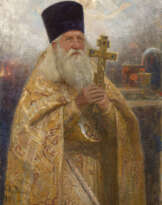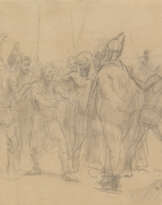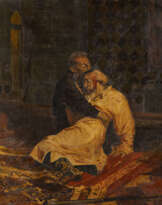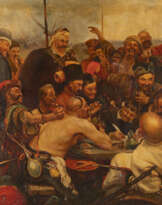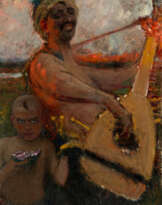ID 980686
Lot 13 | The Meeting of Dante and Beatrice
Estimate value
£ 60 000 – 90 000
, signed.
Oil on canvas, 41.5 by 51.5 cm.
Provenance: Collection of the artist, Kuokkala, Finland.
Acquired by Boris Osipovich Sirpo (1893-1967) in Finland in the late 1920s.
Collection of Boris Sirpo, Finland and USA.
Thence by descent to the present owner.
Private collection USA.
Exhibited: Opyty khudozhestvennogo tvorchestva (eskizov) russkikh i inostrannykh khudozhnikov i uchenikov, The Imperial Society of the Encouragement of the Arts, St Petersburg, December 1896-January 1897.
Ilja Rjepin, Jurij Rjepin and Wasili Levi, The Strindberg Art Salon, Helsinki, 1928.
Prof. Ilia Repinin teoksia, The Strindberg Art Salon, Helsinki, April 1931.
Literature: Katalog Vystavki opytov khudozhestvennogo tvorchestva (eskizov) russkikh i inostrannykh khudozhnikov i uchenikov, dekabr-yanvar 1896-1897, St Petersburg, 1896, No. 114, listed as Vstrecha Dante i Beatriche.
Exhibition catalogue, Ilja Rjepin, Jurij Rjepin and Wasili Levi, Helsinki, Lindbergs Tryckeri Aktiebolag, 1928, No. 13, listed under works by Ilya Repin as Dante & Beatrice.
The Meeting of Dante and Beatrice was painted by Ilya Repin in the 1890s. It was during this time that new subjects and a new style appeared in his art. Colour and colouristic harmonies became the most expressive language of his paintings, instead of the psychology and plasticity of forms.
The painting was first exhibited at the Exhibition of Artistic Experiments in St. Petersburg in 1896.
It was in 1897 that Repin accepted the role of symbolism, impressionism and even decadence in his article “In Defence of the New Academy of Arts” about different artistic movements: “Our duty is to attempt to understand, study and help to develop new movements, instead of imposing our favourite genre. Art is undergoing an evolution right before our eyes. There is no way of undoing this. (I.E. Repin, “In Defence of the New Academy of Arts”, Knizhki Nedeli, 1897, No. 10)
During this period Repin became fascinated with the subject of love and “affairs of the heart”. The artist’s Don Juan and Donna Anna, I Loved You and The Muse appeared at exhibitions. The creation of these works, as well as Repin’s portrayal of the love of Dante and Beatrice from the famous Divine Comedy, were the result of upheaval in his personal life. Without receiving the dissolution of his first marriage, he left his wife in the late 1880s and went through a series of infatuations, loves, true passions and breakups that were particularly painful for him. In 1891, he met Natalia Nordman, who became his life partner, friend and muse. It was to her that he would gift his Penaty Estate, where they would spend 15 years together.
The Meeting of Dante and Beatrice was created at the beginning of Repin’s romantic relationship with Nordman. Out of the numerous subjects in the truly philosophical Divine Comedy, the artist chose the scene of Dante meeting his beloved in the earthly Heaven.
In the poem, Dante describes love as an all-pervasive and caressing light, an allegory which Repin managed to vividly convey and express. The image of love was communicated as something that spilt through colourful environs. The painting exudes light. This light permeates the entire colour fabric of the composition, with the love emitted by Beatrice as its source. The overall forms, dissolving volumes and textures of the visual masses all carry light. An undoubtedly outstanding quality of the etude is the arrangement of light and colour, which is worthy of an experienced impressionist. The space in the etude is worked through with precise accents of light and nuanced interactions between light and colour. Only a master who had a good understanding and command of the skills of impressionism and en plein air painting could have dealt with such a complex artistic task. The artist also managed to convey a feeling of the unreal world of the light of love and truly stepped away from being confined to a genre in his interpretation of the scene.
The Meeting of Dante and Beatrice spent many years at the Penaty Estate and was displayed at exhibitions at Salon Strindberg in Helsinki in 1928 and a memorial exhibition in 1931.
In the late 1920s the work was acquired by Boris Osipovich Sirpo (1893-1967), a renowned violinist, conductor and founder of the Vyborg Music Institute, who lived in Finland between 1912 and 1939. In 1939 Sirpo immigrated to the USA and the work remained in his family after his death.
We would like to thank Tatiana Borodina, Director of Ilya Repin’s Penaty Memorial Estate, for providing this note and additional cataloguing information.
1931 label on the verso of the present lot.
The present lot as listed in the 1928 exhibition catalogue.
| Artist: | Ilya Jefimovitsch Repin (1844 - 1930) |
|---|---|
| Auction house category: | Paintings |
| Artist: | Ilya Jefimovitsch Repin (1844 - 1930) |
|---|---|
| Auction house category: | Paintings |
| Address of auction |
MacDougall Arts Ltd. 33 St James’s Square SW1Y 4JS London United Kingdom | ||||||||||||||
|---|---|---|---|---|---|---|---|---|---|---|---|---|---|---|---|
| Preview |
| ||||||||||||||
| Phone | +44 20 7389 8160 | ||||||||||||||
| Phone | +7 495 799 4683 | ||||||||||||||
| Fax | +44 (0) 20 7389 8170 | ||||||||||||||
| Buyer Premium | 27 % | ||||||||||||||
| Conditions of purchase | Conditions of purchase | ||||||||||||||
| Business hours | Business hours
|





